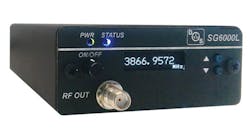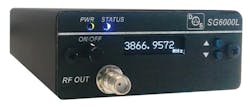Generator Spans 25 to 6000 MHz
For those in need of a simple source of test signals to 6 GHz, the model SG6000L from DS Instruments is a compact test signal generator capable of generating clean sine wave output signals from 25 MHz to 6 GHz. It can be operated by a rudimentary front panel using several push-button controls or by a host PC and its Universal Serial Bus connection. For those in need of higher frequencies, the frequency synthesizer is available with an optional doubler to provide output signals to 12 GHz.
The SG6000L (see figure) is very compact, measuring just 2.75 × 6.00 × 1.13 in. Nonetheless, it provides robust output signals at levels from +6 to +11 dBm through 6 GHz, with typical output level of +8 dBm. When equipped with the optional frequency doubler, the output power ranges from +9 to +14 dBm, with a typical frequency-doubled output-power level of +11 dBm. The output-power flatness for both fundamental-frequency and doubled outputs is typically ±2 dB. For a low-cost source, output signals are relatively clean, with single-sideband (SSB) phase noise of typically -80 dBc/Hz offset 10 kHz from a 6-GHz carrier.
This is a test signal source that provides basic output signals with little fuss or complexity, showing output frequency on an organic light-emitting-diode (OLED) display and controlled by just a few buttons for power and frequency up or down. It can also be controlled by a host computer with a USB port running the supplied software. The signal source runs with industry-standard Standard Commands for Programmable Instruments commands to change frequency and output-power level.
Depending upon the band of operation, the signal source can tune frequencies in steps of 20 Hz or less to a maximum step size of 3 kHz. The OLED display enables operators to see command frequencies from the USB interface or from the front-panel frequency up/down buttons. The USB port is configured on the host PC as a communications port, allowing operators to incorporate the SG6000L in automated test applications.
The synthesized SG6000L signal source can operate with its internal 10-MHz reference source or, as an option, with an external 10-MHz reference source. The signal generator includes an autodetect function to switch to the external reference source when it is connected. The lost-cost signal generator draws its power from the USB port, running on supply voltage of +4.75 to +5.20 VDC. When equipped for the optional external 10-MHz reference, it accepts external reference levels from -20 to +15 dBm to allow a wide range of external oscillators. The simple front panel includes SMA connectors for the fundamental-frequency and doubled-frequency output signals, with worst-case output VSWR of 1.50:1 and typical VSWR of 1.30:1.
DS Instruments, San Luis Obispo, CA 93401; (805) 242-6685

